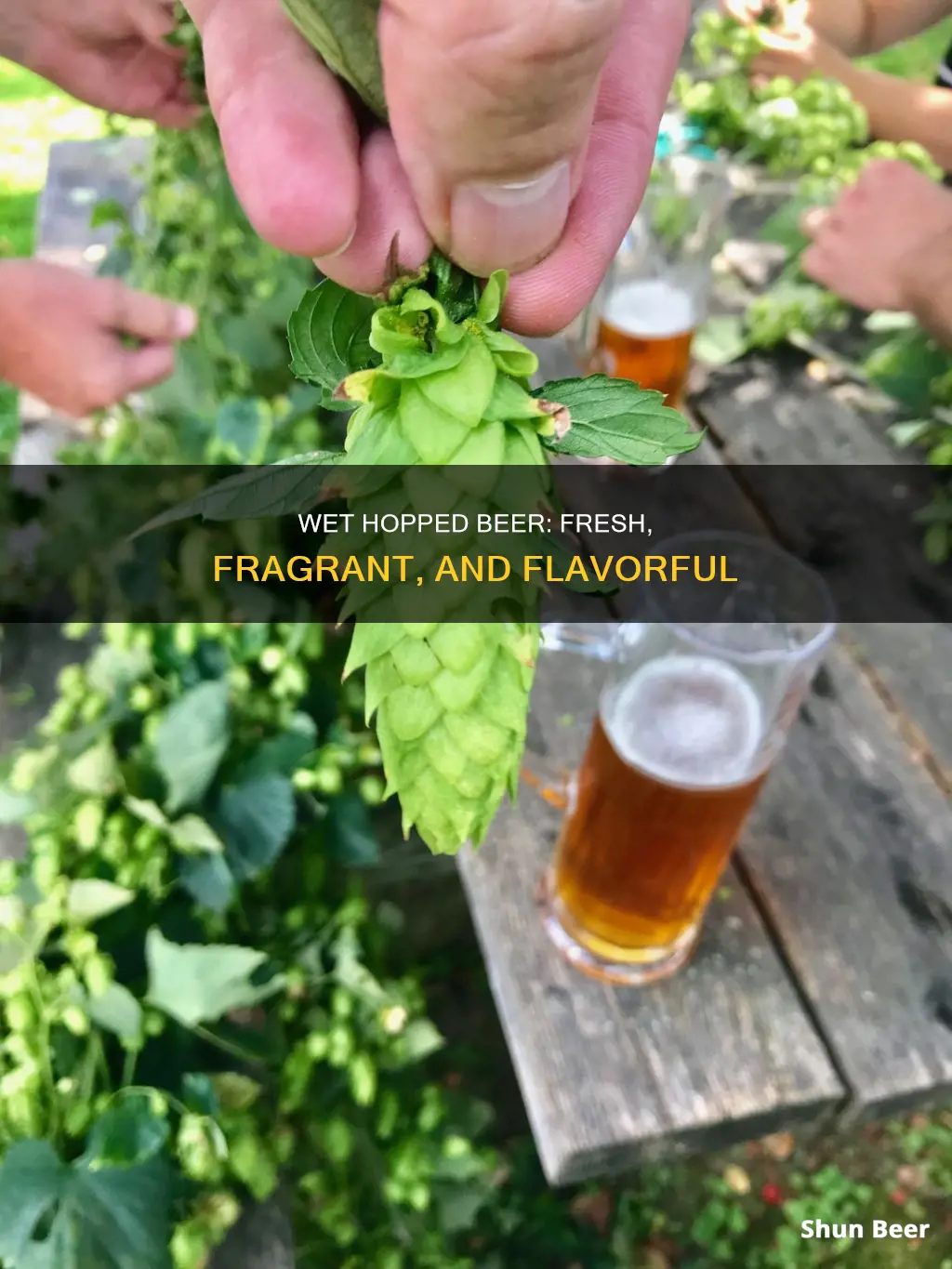
Wet-hopped beer is a type of beer that uses freshly picked hops, added during any stage of the brewing process on the same day they are harvested. Wet hops are hops that are un-kilned and still contain approximately 80% moisture, which is reduced to 9% after harvest. Wet-hopped beers are also referred to as fresh hop beers, green hop beers, or harvest beers. They have a short shelf life and are known for their unique, delicate character and grassy, chlorophyll-like aromatics.
| Characteristics | Values |
|---|---|
| Definition | The process of using un-kilned, freshly picked hops during brewing |
| Timing | Hops are added on the same day they are harvested |
| Harvest Season | Late August to September |
| Moisture Content | Approximately 80% moisture |
| Drying | Moisture reduced to 9% in a hop kiln |
| Transport | Packed in cardboard boxes and shipped directly to the brewery |
| Usage | Used in any stage of the brewing process |
| Beer Type | Beers are referred to as "wet hop", "fresh hop", "green hop", or "harvest" beers |
| Origin | Emerged in the past 10 years, mostly produced by American craft brewers |
| Aroma | Uniquely "green" and delicate, with grassy chlorophyll-like notes |
| Flavour | Grassy, melon, pine, grapefruit, and plant-like flavours |
| Bitterness | Less bitter than dry-hopped beers |
| Quantity | Four to six times more hops are needed by weight compared to dry hops |
| Storage | Should be used within 24 hours of harvest to prevent spoilage |
What You'll Learn

Wet hops are un-kilned and used fresh from the harvest
Wet hops are hops that have been used fresh from the harvest, without being dried or kilned. In the Northern Hemisphere, hops are typically harvested in late August and early September. As hops are around 80% water, they need to be used very soon after harvest, or they will begin to rot. This means that wet hops are usually added to the brewing process on the same day they are picked.
Wet hops are un-kilned, and this is where the "wet" in "wet hopping" comes from. The hops are packed in cardboard boxes and shipped straight to the brewery, where they are used immediately. If they are not used right away, the hops will quickly deteriorate and become unusable.
Wet hops are approximately 80% moisture, and this is reduced to around 9% in a hop kiln after the harvest. Getting the hops dried correctly is critical. If they are left too dry, hops may oxidize, and there is a heightened risk of warehouse fires. If they are left too wet, the hops may "sweat", become mouldy, and develop off-aromas.
Beers produced with un-kilned hops are referred to as "wet hop" beers, "fresh hop" beers, "green hop" beers, or "harvest" beers. These beers are almost exclusively produced by American craft brewers located in hop-growing areas.
Wet hops are added during any stage of the brewing process, and this is one of the key differences between wet and dry hopping. Dry hopping is a technique used to boost hop aroma without enhancing hop bitterness, and the hops are added late in the brewing process, during fermentation or conditioning.
Funky Buddha Hop Gun — A Hoppy Beer?
You may want to see also

Wet hops are approximately 80% water, reducing to 9% after kilning
Wet-hopped beers are beers that use freshly picked hops during the brewing process. Hops are the flowers, or cones, of the humulus lupulus plant. They add bitterness, aroma, and flavour to beer, as well as helping it to retain its head of foam.
Wet hops are hops that have not been dried. They are used immediately after being picked, as they will start to rot within a matter of days. They are also referred to as "fresh hops", although this term can also mean hops used right out of the oast house.
Wet hops are approximately 80% water. This high moisture content means that brewers typically need to use four to six times the weight of wet hops as they would for the same variety of kiln-dried hops. For example, one ounce of pelleted dry hops would be the equivalent of four to six ounces of wet hops. This difference in weight needs to be accounted for when formulating a beer recipe.
After being picked, hops are dried in a kiln to reduce their moisture content to around 9%. This process is critical, as hops that are left too dry may oxidise and increase the risk of warehouse fires, while hops that are left too wet may become mouldy and develop off-aromas. The kilning process also impacts the flavour of the hops, as delicate and volatile aroma oils are lost during the heating process.
Sedative Hops: Brewing Relaxing Beers With These Hops
You may want to see also

Wet hops are used by brewers immediately, or they will spoil
Wet hops are hops that have not been dried after picking. They are also known as fresh hops, and are used by brewers to make "wet hop" or "fresh hop" beers. Wet hops are approximately 80% water, and they begin to spoil very soon after being picked. Therefore, they need to be used immediately in the brewing process, or they will become unusable.
Wet hops are typically used during the annual hop harvest, which in the Northern Hemisphere takes place in late August and September. Brewers will often rush the freshly picked hops straight from the field to the brewery, where they are added to the boil on the same day they are harvested.
The wet hopping technique involves adding the hops at any stage of the brewing process, from the beginning of the boil to the end of fermentation. Wet hops are added to the beer in their whole-cone form, and they impart a super green, chlorophyll-like aroma and flavour.
Because wet hops have a high moisture content, brewers typically need to use four to six times the weight of wet hops as they would use for the same variety of dried hops. Wet hops also take up more room in the kettle, so brewers may need to reduce the batch size.
Wet hops are prized for the unique, delicate aromas and flavours they impart to beer. However, they must be used in moderation, as too much can result in an overpowering "grassy" taste.
Hops in Beer: What Else Contains This Ingredient?
You may want to see also

Wet hops are added at any stage of the brewing process
Wet-hopped beer is a style of beer that has emerged largely in the past decade and is almost exclusively produced by American craft brewers located in hop-growing areas. Wet hops are hops that are used in the brewing process without being dried first. They are typically added to the brewing process on the same day that they are harvested.
Wet hops are the un-kilned, freshly picked hops from the Humulus Lupulus plant. They are used in the brewing process in their whole-cone form. The hops are added during the brewing process, at any stage, to capture their delicate and volatile aroma oils in the finished beer.
Wet hops are approximately 80% moisture and this is reduced in a hop kiln right after harvest to about 9%. Getting the hops dried correctly is critical. If they are left too dry, the hops may oxidize, and there is a heightened risk of warehouse fires. If they are left too wet, baled hops may "sweat", become moldy, and develop off-aromas. When brewers use hops wet, they must be loosely packed in cardboard boxes right after picking and shipped via the fastest method straight to the brewery, where they are used immediately. If they aren't used right away, the hops will deteriorate quickly, becoming unusable.
Dry Hopping Beer: Pellet Power for Aromatic Brews
You may want to see also

Wet hops are used to capture delicate aroma oils
The high moisture content of wet hops means that brewers typically need to use four to six times the weight of wet hops compared to kiln-dried hops. Wet hops also take up more room in the kettle, so batch sizes may need to be reduced. Despite these challenges, brewers use wet hops to capture delicate aroma oils that may be lost during the kilning process.
Wet hops are added to the brewing process at any point, including during the boil, at the end of the boil, or during fermentation or conditioning. The essential oils in hops are responsible for the desired hoppy aromas and flavours in beer. These oils change in the days before the hops are picked and continue to change after they are dried and stored. Therefore, using wet hops can result in different odour compounds and aroma profiles compared to dried hops.
Wet hops impart a uniquely "green" delicate character to beers, with grassy, plant-like, and chlorophyll-like aromatics. While some beer enthusiasts enjoy these flavours and aromas, others may find them off-putting. Nevertheless, wet-hopped beers represent a fascinating evolution of the brewer's art, showcasing the unique flavours and aromas that can be captured by using fresh ingredients.
Hop Acids' Intricate Influence on Beer's Flavor and Aroma
You may want to see also
Frequently asked questions
Wet-hopped beer is beer brewed with freshly picked hops, added during any stage of the brewing process on the same day they are harvested.
Dry-hopped beers are those where hops are added late in the brewing process, during fermentation or conditioning, to extract alpha acids and create a bitter flavour. Wet-hopped beers, on the other hand, use fresh, un-kilned hops.
Wet-hopped beers are brewed during the hop harvest season, usually from late August to September.
Wet-hopped beers are said to have a "super green, chlorophyll-like aroma and flavour". They can also have grassy, melon, pine, and grapefruit notes.
Wet-hopped beers are almost exclusively produced by American craft brewers located in hop-growing areas, such as the Pacific Northwest, Yakima Valley, and Oregon's Willamette Valley.







